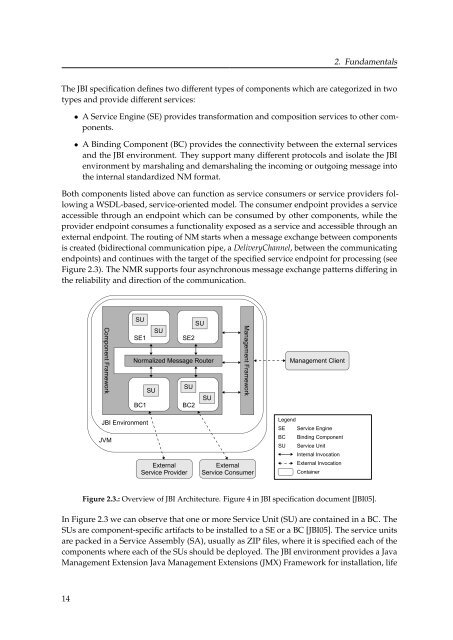Diploma Thesis Santiago Gómez Sáez - IAAS
Diploma Thesis Santiago Gómez Sáez - IAAS
Diploma Thesis Santiago Gómez Sáez - IAAS
Create successful ePaper yourself
Turn your PDF publications into a flip-book with our unique Google optimized e-Paper software.
Management Framework<br />
Component Framework<br />
2. Fundamentals<br />
The JBI specification defines two different types of components which are categorized in two<br />
types and provide different services:<br />
• A Service Engine (SE) provides transformation and composition services to other components.<br />
• A Binding Component (BC) provides the connectivity between the external services<br />
and the JBI environment. They support many different protocols and isolate the JBI<br />
environment by marshaling and demarshaling the incoming or outgoing message into<br />
the internal standardized NM format.<br />
Both components listed above can function as service consumers or service providers following<br />
a WSDL-based, service-oriented model. The consumer endpoint provides a service<br />
accessible through an endpoint which can be consumed by other components, while the<br />
provider endpoint consumes a functionality exposed as a service and accessible through an<br />
external endpoint. The routing of NM starts when a message exchange between components<br />
is created (bidirectional communication pipe, a DeliveryChannel, between the communicating<br />
endpoints) and continues with the target of the specified service endpoint for processing (see<br />
Figure 2.3). The NMR supports four asynchronous message exchange patterns differing in<br />
the reliability and direction of the communication.<br />
SU<br />
SE1<br />
SU<br />
SE2<br />
SU<br />
Normalized Message Router<br />
Management Client<br />
BC1<br />
SU<br />
SU<br />
BC2<br />
SU<br />
JBI Environment<br />
JVM<br />
External<br />
Service Provider<br />
External<br />
Service Consumer<br />
Legend<br />
SE Service Engine<br />
BC Binding Component<br />
SU Service Unit<br />
Internal Invocation<br />
External Invocation<br />
Container<br />
Figure 2.3.: Overview of JBI Architecture. Figure 4 in JBI specification document [JBI05].<br />
In Figure 2.3 we can observe that one or more Service Unit (SU) are contained in a BC. The<br />
SUs are component-specific artifacts to be installed to a SE or a BC [JBI05]. The service units<br />
are packed in a Service Assembly (SA), usually as ZIP files, where it is specified each of the<br />
components where each of the SUs should be deployed. The JBI environment provides a Java<br />
Management Extension Java Management Extensions (JMX) Framework for installation, life<br />
14

















